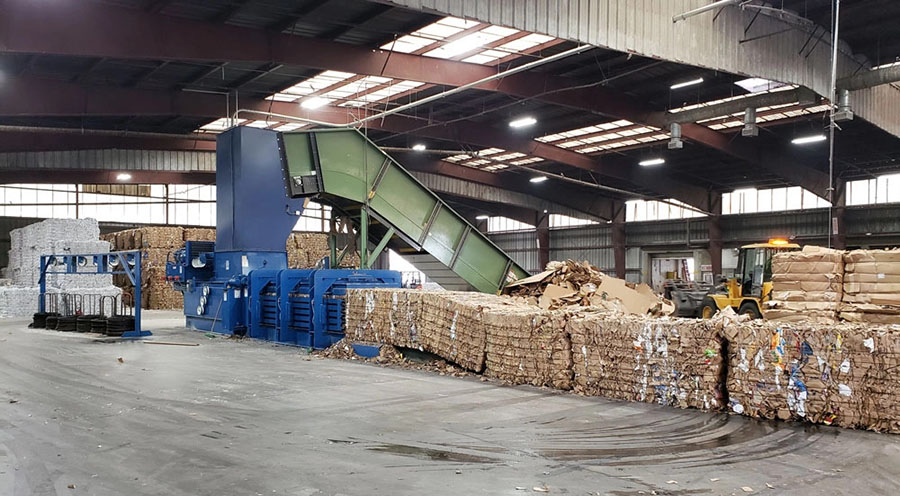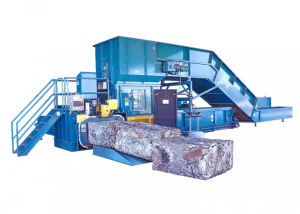Baler machines play a pivotal role in modern waste management and recycling processes, serving as essential tools for compressing and packaging various materials. From paper and plastic to metal and agricultural products, these machines efficiently reduce the volume of waste, facilitating easier handling, transportation, and recycling.
Understanding Baler Machines

Baler machines enhance operational efficiency and contribute to environmental sustainability by transforming loose, cumbersome materials into compact, manageable bales.
This introduction will explore baler machines’ fundamental workings, types, and applications, highlighting their importance across diverse industries.
Basic Operation Principles
Baler machines compress materials like paper, plastic, and metal into reduced volumes using a hydraulic or mechanical pressing mechanism. The material is fed into the machine’s chamber, compacted and secured into bales for easy handling and transportation. This operation is crucial for streamlining recycling and waste management efforts.
Importance in Waste Management
Baler machines optimize recycling and improve material handling by converting loose materials into compact bales. This efficiency cuts transportation costs and minimizes the environmental impact by reducing the number of transport trips needed.
Additionally, balers help maintain a cleaner and safer work environment, making them vital in various sectors such as manufacturing, retail, and agriculture.
Types of Baler Machines
Baler machines come in various designs to meet different industries’ waste management and recycling needs. Each type offers unique features and benefits, tailored to specific materials and volume requirements. Here’s a look at the primary types of baler machines:
Vertical Balers

Vertical balers are the most common type in smaller retail outlets, warehouses, and manufacturing units. They operate by compacting waste vertically and are ideal for businesses with limited space.
Vertical balers are easy to use and maintain, making them suitable for compressing cardboard, plastic, and other lightweight materials. Their compact footprint and lower cost make them a popular choice for small to medium volumes of waste.
Horizontal Balers

Horizontal packaging machines are designed for large-scale waste treatment and are typically used in a broader range of recycling facilities and manufacturing plants. These machines horizontally compress waste and process various materials, including paper, cardboard, plastic, and metal.
Horizontal balers often feature automated feeding systems, making them more efficient, significant, and expensive than their vertical counterparts.
Two-Ram Balers

Two-ram balers offer enhanced flexibility and efficiency for processing large volumes of diverse materials. Unlike single-ram balers, they use two rams – one for compressing the material and another for ejecting the bale.
This design allows for continuous operation and the ability to bale multiple types of materials without stopping for adjustments. Two-ram balers are ideal for facilities that handle a wide range of materials and require high throughput.
Specialty Balers
Specialty balers are engineered for specific materials or applications that standard balers cannot adequately process. This category includes balers for textiles, foam, agricultural products like hay and straw, and even metal. Specialty balers may feature unique mechanisms and configurations to effectively compress and bind the particular materials they are designed for.
Applications of Baler Machines

Baler machines serve various applications across various industries, demonstrating their versatility and importance in promoting sustainability and efficiency in waste management.
Here’s how they are applied in different sectors:
Recycling Industry
In the recycling sector, baler machines are indispensable for compacting and binding recyclable materials such as paper, cardboard, plastics, and metals. By making these materials into dense, transportable bags, the baler significantly reduces the volume of waste, making it easier to handle, store, and transport to recycling facilities. This streamlines the recycling process and enhances the economic viability of recycling operations by lowering transportation costs and improving sorting efficiency.
Agriculture
Agriculture is another prominent area where baler machines are critical, particularly in managing crop residues and producing hay bales. For farmers, balers are essential for compacting straw, hay, and other agricultural products into bales that are easy to handle, store, and feed to livestock.
This application helps in farm waste management and supports the efficient utilization of agricultural by-products.
Industrial and Commercial
Baler machines contribute to waste reduction efforts in industrial and commercial settings by compacting large volumes of packaging materials, production scraps, and other waste products.
Businesses can minimize their waste footprint, enhance workplace safety, and potentially generate revenue from selling compacted recyclables. Balers are particularly beneficial in environments where space for waste storage is limited, as they maximize the efficiency of waste handling and disposal processes.
Municipal Solid Waste Management
Municipalities utilize baler machines to manage solid waste more effectively. By compacting household and commercial waste, cities can optimize the transportation and disposal of waste, reducing the need for landfill space and contributing to environmental conservation efforts.
Baler machines in municipal settings often handle various materials, demonstrating their adaptability to waste management challenges.
Benefits of Using Baler Machines
Adopting baler machines across various industries brings many benefits, from environmental to economic and operational advantages.
Here’s an overview of the key benefits:
Environmental Impact
Waste Reduction: Baler machines significantly reduce the volume of waste by compacting waste materials into dense bales, leading to less landfill use and a lower environmental footprint.
Recycling Efficiency: Balers make the transportation, sorting, and processing of recyclable materials easier, thereby enhancing the recycling process, helping to protect natural resources, and reducing pollution.
Economic Advantages
Cost Savings: Compacting waste reduces transportation and disposal costs, as more material can be transported in one trip. For recyclable materials, baled commodities can often be sold, generating additional business revenue.
Space Efficiency: By reducing waste volume, baler machines free up valuable floor space, optimizing the use of premises and potentially decreasing storage costs.
Operational Efficiency
Improved Workplace Safety: Baler machines help maintain a cleaner work environment by efficiently managing waste materials, reducing the risk of accidents, and promoting a safer workplace.
Time Savings: Automating the waste compaction process with baler machines saves time and labor, allowing employees to focus on more productive tasks.
Regulatory Compliance: Proper waste management using baler machines can help businesses comply with environmental regulations, avoid fines, and contribute to corporate social responsibility efforts.
Versatility
Adaptability: The wide range of baler machines available means businesses can find a model that perfectly suits their specific waste management needs, whether they are handling paper, plastic, metal, or agricultural products.
Customization: Many baler machines offer customization options, allowing for adjustments in bale size, pressure settings, and binding materials to optimize the baling process for different types of waste or recyclables.
Sustainability
Circular Economy Contribution: By promoting material recycling and reuse, bundling machines play a crucial role in the circular economy, minimizing waste and utilizing resources for the longest possible time.
Selection Criteria for Baler Machines
Selecting the suitable baler machine for your operations requires careful consideration of several factors to ensure efficiency, cost-effectiveness, and sustainability in waste management practices.
Here are key criteria to guide your selection:
Material Volume and Type
Assess the Volume: Assess the amount of materials that must be processed daily or monthly. This will help determine the baler’s size and capacity that suits your needs.
Material Type: Different baler machines are optimized for specific materials, such as paper, cardboard, plastics, or metals. Choose a machine that best matches the primary materials you intend to bale, considering factors like density, compressibility, and recycling value.
Space Availability
Footprint: Consider the available space in your facility. Vertical balers require less floor space and are suitable for businesses with limited area, while horizontal balers, though larger, offer greater capacity and efficiency for high-volume applications.
Installation and Operation Space: Ensure the machine has enough room and safe operation, maintenance access, and material handling around the baler.
Budget and Cost-Efficiency
Initial Investment: Compare the upfront cost of different baler machines. Remember that higher-capacity and automated models are more expensive but may offer significant long-term savings and efficiency.
Operating Costs: Consider energy consumption, maintenance requirements, and the cost of consumables like baling wire or straps. A more efficient baler, though initially expensive, may reduce long-term operating costs.
Efficiency and Throughput
Processing Speed: High-volume operations may benefit from a baler machine with a faster cycle time and automatic feeding features, ensuring a continuous and efficient baling process.
Ease of Use: User-friendly controls, easy maintenance access, and safety features can improve operational efficiency and reduce downtime.
Environmental and Regulatory Considerations
Sustainability Goals: Choose a baler that supports your organization’s sustainability objectives, such as reducing carbon footprint, enhancing recycling rates, and contributing to a circular economy.
Compliance: Ensure the baler meets local environmental regulations and safety standards, reducing the risk of fines and supporting corporate social responsibility initiatives.
After-Sales Support
Warranty and Service: Look for reputable manufacturers that offer comprehensive warranties, readily available spare parts, and responsive customer service and technical support.
Maintenance and Safety Considerations
Effective maintenance and adherence to safety protocols are crucial for ensuring baler machines’ longevity and safe operation. Here’s an overview of critical considerations to keep in mind:
Routine Maintenance Practices
Regular Inspections: Conduct daily or weekly inspections to check for signs of wear, leaks, or damage. Focus on critical components like hydraulic systems, electrical wiring, and the structural integrity of the chamber and door.
Lubrication: Regularly lubricate moving parts to reduce friction and wear. Follow the manufacturer’s guidelines on the type and frequency of lubricant use.
Cleaning: Keep the machine and its surrounding area clean to prevent the accumulation of waste materials that could cause blockages or fire hazards. Pay special attention to the baler’s compressing chamber and ejecting mechanism.
Professional Servicing: Schedule annual or bi-annual check-ups with a skilled service technician who can perform in-depth maintenance tasks, including hydraulic fluid changes, pressure adjustments, and thorough safety checks.
Safety Protocols
Operator Training: Ensure that all operators are adequately trained on the safe use of the baler machine, including starting and stopping procedures, emergency stops, and understanding of all safety features.
Personal Protective Equipment (PPE): Operators and maintenance personnel must wear appropriate personal protective equipment, such as gloves, safety goggles, and steel-toe boots, to prevent potential hazards.
Safety Features: Regularly test safety mechanisms, such as emergency stop buttons, safety interlocks, and protective devices, to ensure their functionality and integrity.
Clear Signage: Place warning labels and operational instructions prominently on the machine to remind operators of safety practices and how to use the machine correctly.
Emergency Preparedness
Emergency Procedures: Develop and communicate clear procedures for dealing with potential accidents or machine malfunctions. This includes training staff on how to respond to fires, hydraulic fluid leaks, and injuries.
First Aid and Fire Safety Equipment: Ensure kits and fire extinguishers are available near the baler machine area.
Conclusion
Baler machines are vital for efficient waste management and recycling, providing substantial environmental, economic, and operational advantages. Selecting the appropriate baler, with regular maintenance and adherence to safety practices, maximizes these benefits and ensures the machine’s longevity and operator safety.
As the demand for sustainability grows, the role of baler machines in facilitating effective waste handling and promoting recycling efforts becomes increasingly crucial. Investing in a baler machine is a strategic move for any organization aiming to enhance its recycling processes and contribute to a more sustainable future.




